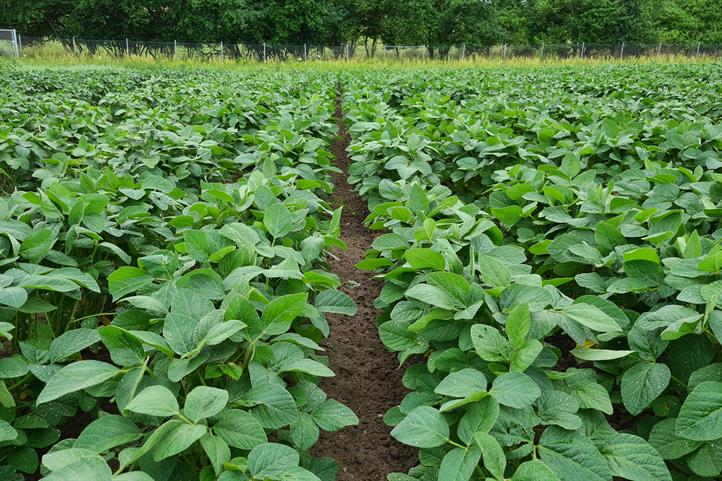Germany
January 4, 2023

In the long term, more and more arable land in Europe will be suitable for growing soybeans. This could reduce dependence on soybean imports from Brazil and the USA. Source: © ZALF / Moritz Reckling.
Climate change requires a rethink of crop production towards varieties and crops that are better adapted to heat and drought. Soybean is an arable crop that thrives in warm conditions and provides itself with nitrogen, an important plant nutrient that otherwise farmers would have to fertilize. A study published by the Leibniz Centre for Agricultural Landscape Research (ZALF) in the scientific journal "Global Change Biology" shows that in the long term, more and more arable land in Europe will become suitable for soy production. This effect exceeds the yield losses that are to be expected due to increasing heat and drought, especially in southern Europe. According to the authors of the study, this would enable the EU to do without a large proportion of soybean imports from Brazil and the USA in the future.
Soybeans are already grown in France, Italy, Serbia, Romania and Austria, often under artificial irrigation. "Expanding soybean cultivation in previously cooler regions expands the possibilities for farmers to make their crop rotations more diverse and thus mitigate the risk of weather-related yield losses and increase biodiversity", explains Prof. Claas Nendel, head of the study presented. It helps that the soy plant, as a legume, is able to absorb nitrogen directly from the air, so that fertilisation with this urgently needed nutrient may forgo. This also reduces negative environmental impacts, such as the release of excess fertilizer into groundwater.
Breeding must target heat stress
"Under warmer conditions, soybeans yield more than was previously possible with soy varieties adapted to cool temperatures in Germany", explains Dr Moritz Reckling, who conducts research on legume cultivation at ZALF. Generally, soybeans need a lot of water at the beginning of the season, but dry weather for ripening and harvesting. Since soybeans in Germany are in the field until October, precipitation at harvest time has so far been a major risk. The simulations with plant growth models also show that the previous production risks due to cool and wet weather will tend to decrease in the future, while drought and heat stress in particular will grow into a serious risk. Due to the limited water resources in Europe, an expansion of irrigation can only help to a limited extent, so that breeding is called upon to expand its focus on drought- and heat-tolerant soybean varieties.
Project partners:
- Leibniz Centre for Agricultural Landscape Research (ZALF), Müncheberg
- University of Potsdam
- Global Change Research Institute of the Czech Academy of Sciences, Brno
- INRAE, Toulouse
- Finnish Environment Institute (SYKE), Helsinki
- Agvolution GmbH, Göttingen
- Institute of Field and Vegetable Crops, Novi Sad
- Georg-August-Universität Göttingen
- University of Agriculture, Kraków
- Terres Inovia, Baziege
- Federal University Goiás
Funding:
Federal Ministry of Education and Research (BMBF), Germany (01DR17011A); Academy of Finland (330915); Ministry of Education, Youth and Sports of the Czech Republic (CZ.02.1.01/0.0/0.0/16_019/000797)
Further information:
https://onlinelibrary.wiley.com/doi/10.1111/gcb.16562
Eine Chance im Klimawandel: Sojaproduktion in Europa künftig ausweiten
Der Klimawandel erfordert ein Umdenken in der Pflanzenproduktion, hin zu Sorten und Kulturen, die besser an Hitze und Trockenheit angepasst sind. Die Sojabohne gedeiht nicht nur unter warmen Bedingungen gut, sondern versorgt sich auch selbst mit dem wichtigen Pflanzennährstoff Stickstoff. Eine vom Leibniz-Zentrum für Agrarlandschaftsforschung (ZALF) in der Fachzeitschrift „Global Change Biology“ veröffentlichte Studie zeigt, dass sich langfristig immer mehr Ackerflächen in Europa für die Sojaproduktion eignen. Dieser Effekt übersteige dabei die Ertragseinbußen, die durch zunehmende Hitze und Trockenheit vor allem in Südeuropa zu erwarten seien. Damit könne die EU zukünftig auf einen großen Teil der Sojaimporte aus Brasilien und den USA verzichten, so die Autorinnen und Autoren der Studie.
Sojabohnen werden bereits in Frankreich, Italien, Serbien, Rumänien und Österreich angebaut, zum großen Teil mit künstlicher Bewässerung. „Eine Ausweitung des Sojaanbaus in bislang kühleren Regionen erweitert die Möglichkeiten für die Landwirtinnen und Landwirte, ihre Fruchtfolgen diverser zu gestalten und damit das Risiko für wetterbedingte Ertragseinbußen zu mildern und die Artenvielfalt zu erhöhen“, erklärt Prof. Claas Nendel, Leiter der vorgelegten Studie. Dabei hilft, dass die Sojapflanze als Hülsenfrucht, eine sogenannte Leguminose, in der Lage ist, Stickstoff direkt aus der Luft aufzunehmen, so dass auf eine Düngung mit diesem dringend benötigten Nährstoff verzichtet werden kann. Auf diese Weise können auch negative Umweltfolgen, etwa durch Austrag von überschüssigem Dünger in das Grundwasser, verringert werden.
Züchtung muss Hitzestress ins Visier nehmen
„Unter wärmeren Bedingungen liefert die Sojabohne mehr Ertrag, als es bislang mit den an kühle Temperaturen angepassten Sojabohnensorten in Deutschland möglich war“, erläutert Dr. Moritz Reckling, der am ZALF zum Anbau von Leguminosen forscht. Grundsätzlich braucht Soja zu Beginn der Saison viel Wasser, aber trockenes Wetter zur Reife und Ernte. Da Soja in Deutschland bis in den Oktober auf dem Feld steht, ist Niederschlag zur Erntezeit bislang ein großes Risiko. Die am ZALF angewendeten Simulationen mit Pflanzenwachstumsmodellen zeigen, dass die bisherigen Produktionsrisiken durch kühle und nasse Witterung zukünftig eher zurückgehen, während insbesondere Trocken- und Hitzestress zu einem ernstzunehmenden Risiko heranwächst. Durch die begrenzten Wasserressourcen in Europa kann eine Ausweitung der Bewässerung nur bedingt helfen, so dass die Züchtung aufgefordert ist, ihren Fokus auf trocken- und hitzetolerante Sojasorten zu erweitern.
Projektpartner:
- Leibniz-Zentrum für Agrarlandschaftsforschung (ZALF), Müncheberg
- Universität Potsdam
- Global Change Research Institute of the Czech Academy of Sciences, Brno
- INRAE, Toulouse
- Finnish Environment Institute (SYKE), Helsinki
- Agvolution GmbH, Göttingen
- Institute of Field and Vegetable Crops, Novi Sad
- Georg-August-Universität Göttingen
- University of Agriculture, Kraków
- Terres Inovia, Baziege
- Federal University Goiás
Förderhinweis:
Federal Ministry of Education and Research (BMBF), Germany (01DR17011A); Academy of Finland (330915); Ministry of Education, Youth and Sports of the Czech Republic (CZ.02.1.01/0.0/0.0/16_019/000797)